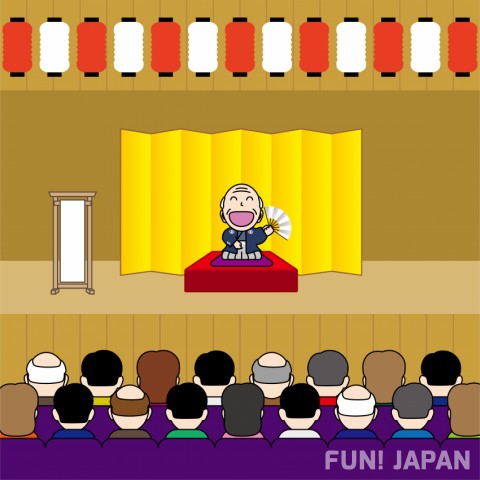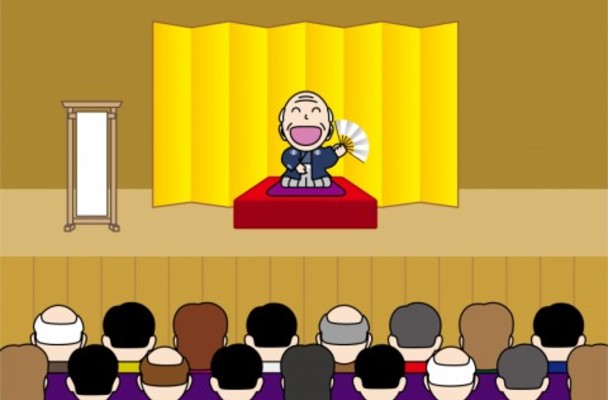
Rakugo is one of Japan's many traditional arts. Different from other traditional arts originating from Japan, Rakugo can be performed by a single person. Furthermore, it does not require any kind of props, allowing the performer to further the story using simply their body's movements. Rakugo also doesn't have any kind of special stage or costume, it simply has the storyteller wearing simple clothing and telling a story. Based on the storyteller's skill, the listener's imagination can be taken to places never before known possible, it's a very unique and characteristic art form.
Let's take a look at Rakugo's history, categories, and where you can see it for yourself.
History
We're going to go back in time towards the end of the Muromachi period (1333-1573 CE) and the start of the Azuchi-Momoyama period (approx. 1558-1600 CE). It is said that the beginning of the Rakugo art form can be found with the speakers with which the daimyo in the Warring States period of Japan spoke to known as "Otogishu" or "Story Tellers".
There are records of a sole monk, who, before Toyotomi Hideyoshi, made a comical error during one of his talks that received high praise. From the Edo period (1603-1868 CE) onwards, these kinds of stories with comical happenings started to be sold to people who wished to listen to them. It is from here that Rakugo began its journey across Japan gaining more and more popularity among the people.
Categories
There are 2 main categories in Rakugo, "Classical Rakugo" and "New Rakugo". Classical Rakugo refers to stories that were made before and up until the Taishō period (1912-1926), whilst New Rakugo refers to stories that were made after that time.
Any and all stories that have a punch line to them are defined as Rakugo, so we're going to talk some more in-depth classifications, it might get a little confusing, but there are around 10 main roles in total. Villager, Warrior, Yotaro (slow-witted fellow, typically the character who keeps on making the same mistake, etc.), Traveller, Expert, Drunkard, Kuruwa (Red light district worker), and a few more. Typically, the stage for these stories is everyday life.
The Structure of Rakugo Stories
Most Rakugo stories are that of a typical everyday person, they usually begin with a few laughs, and end with a giant conclusion and burst of laughter, the structure is easy to understand and is known as "Kishōtenketsu". It's typical in Japan for these stories to use names from famous Japanese people that everyone will know. If you're not a fan of spoilers, don't read on!
Master Katsura Bunchin's "Scary Buns"
The village boys were all together, talking about what they found scary, things such as snakes, spiders, bats, and hairy caterpillars, however, one boy said "I think steamed buns are scary." After hearing this, the boys from the group decided to buy all of the steamed buns in the village and keep sending them to the boy. It's really funny thinking about the boy receiving all of these steamed buns, however, in reality, the boy loved steamed buns. He lied, and just wanted to get steamed buns for free.
Master Tatekawa Danshi's "Jugemu"
A child was born into the family of a certain man's family, in a certain village. They thought that they would like to boy to live healthily, happily, and long, as would any family, and so asked priests for a name and words that had good luck, they decided to make the child's name all of these words, which ended up with the child's name being as follows:
Jyugemu Jyugemu Goko no surikire Kaijarisuigyo no Suigyomatsu Uraimatsu Kunerutokoro ni Sumutokoro Yaburakoji no Burakoji Paipo Paipo Paipo no Shurigan Shurigan no Gurindai Gurindai no Ponpokopi no Ponpokona no Chokyumei no Chosuke
Kosan Yanagiya's "Tokisoba"
Many Rakugo stories actually seem to involve Soba stores, which used to be a very famous fast food in Japan. It's in one of these Soba stores that this story takes place, during payment, they ask "What time is it?" to try and trick the store into saying the time is the payment, this is what's known as "Tokisoba", which roughly translates into "Time Soba". Both successes and failures can be seen in these stories, but you'll laugh no matter which you hear. However, the thing you should pay the most attention to, is how real the sound of the actor eating soba is! It's not something young storytellers are able to replicate easily.
Theaters where you can see Rakugo
The place where you can see Rakugo is known as "Yose" or "Entertainment Hall". Here you can see not only Rakugo, but other forms of storytelling, manzai (comic dialogue), musical performances, magic shows, acrobatics, and many more traditional Japanese art forms. You will always see men and women of all ages gathering here, and when a famous artist is planned to perform, there are even times when you can't even sit down!
Find out more about these entertainment halls in this article: What is Yose?

Comments